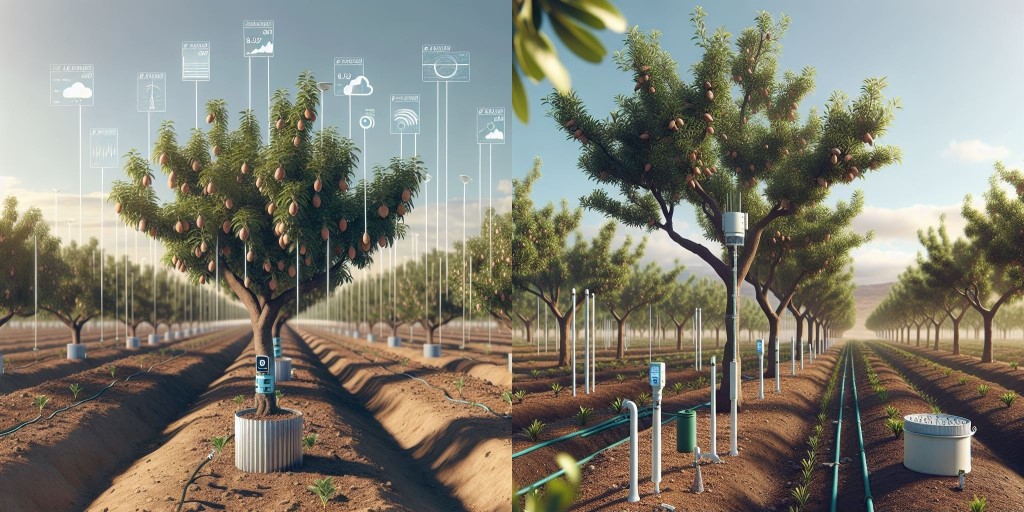
Almond Sustainability Considerations: Ensuring Sustainability in Almond Farming
Sustainability in almond farming is crucial to protect the environment, conserve resources, and maintain long-term productivity. Sustainability in almond farming is a multifaceted approach that aims to balance environmental stewardship, social responsibility, and economic viability. Given the increasing global demand for almonds, ensuring sustainable practices in almond cultivation is crucial for long-term crop productivity, environmental health, and community well-being. Below are key areas where sustainability considerations can be implemented in almond farming:
Water Conservation
Efficient water use is critical in almond farming, especially given the crop’s high water needs and the pressures of climate change. Almond growers must adopt practices that optimize water resources while maintaining productivity.
- Drip Irrigation Systems: This method delivers water directly to the plant’s root zone, reducing evaporation and runoff. It also allows precise control over the water volume, enabling adjustments based on soil moisture levels and plant needs.
Example: Almond growers in California have increasingly adopted drip irrigation, leading to a reduction in water use by up to 33% compared to flood irrigation.
- Soil Moisture Sensors: These sensors provide real-time data on soil water content, allowing for precise irrigation scheduling. They help farmers avoid overwatering, reduce water waste, and maintain optimal soil conditions.
- Deficit Irrigation: This approach applies less water than is typically needed during certain non-critical stages of plant growth (e.g., post-harvest), reducing water consumption without affecting yield quality.
- Water Recycling: On-farm water recycling systems capture and reuse water for irrigation. This reduces reliance on external water supplies, which is particularly valuable in drought-prone areas.
Example: Some almond farms in Spain have integrated water recycling systems, which have proven effective in arid climates, cutting water use significantly.
Soil Health and Fertility
Effective soil management is essential for maintaining long-term crop productivity. Almond farmers should prioritize enhancing soil fertility through proper water, mineral, and soil management. This includes using the right soil amendments, applied in appropriate quantities and at optimal times, to support healthy soil biology while reducing the negative effects of intensive farming practices.
- Cover Cropping: Planting cover crops, like legumes or grasses, all the year around or during the off-season provides multiple benefits. These crops improve soil structure, enhance moisture retention, and prevent erosion while fostering a habitat for natural predators that help control pests and diseases. Additionally, cover crops contribute organic matter to the soil, enhancing nutrient cycling and significantly enriching soil biodiversity. This practice not only boosts soil health but also promotes a more resilient ecosystem by supporting a diverse range of beneficial organisms.
Example: Studies show that cover crops can reduce soil erosion by up to 75% while enhancing nutrient retention in almond orchards.
- Reduced Tillage: Minimizing tillage prevents soil compaction, improves water infiltration, and protects the soil microbiome, which is essential for nutrient breakdown and plant health. Reduced tillage also decreases fuel use and greenhouse gas emissions.
- Nutrient Management: A data-driven approach to fertilizer application, guided by soil and leaf tissue analyses, ensures that nutrients are applied in precise amounts based on crop requirements. This prevents over-fertilization, reducing nutrient runoff into water bodies and cutting down on unnecessary inputs.
Example: In California, almond growers who follow nutrient management plans based on soil tests have reduced nitrogen runoff by 15-20%, helping protect local waterways.
Integrated Pest Management (IPM)
Almond farming contends with numerous pest challenges, ranging from insects to plant diseases. Sustainable pest management aims to minimize reliance on chemical pesticides, instead favoring more natural and integrated approaches. In this context, a pest or disease is defined by the harsh reality of its economic impact: any organism that causes more damage to the crop than the cost of controlling it crosses the threshold, becoming a problem not easily dismissed.
- Biological Controls: Introducing natural predators, such as beneficial insects (e.g., ladybugs, parasitic wasps), can effectively manage pest populations without harming the ecosystem. These beneficial species help keep harmful pests like aphids and mites under control.
Example: In California, some almond orchards have successfully implemented biological control methods, reducing pesticide use by up to 50%.
- Pheromone Disruption: Pheromone traps disrupt the mating patterns of pests by confusing them and preventing reproduction. This technique is particularly effective against pests like the navel orangeworm, a major threat to almond crops.
- Cultural Practices: Crop rotation, timely pruning, sanitation practices (removing fallen nuts and debris), and using pest-resistant almond varieties can all contribute to minimizing pest outbreaks.
Example: By removing fallen nuts (a host for pests like the navel orangeworm), almond growers in Australia have significantly reduced the pest population and improved crop quality.
H2 Title: Energy Efficiency and Carbon Footprint Reduction
Almond farming has the potential to lower its carbon footprint by adopting more energy-efficient practices and utilizing renewable energy sources.
- Solar Power: Almond farms can install solar panels to power irrigation pumps and processing facilities. This reduces dependency on fossil fuels and cuts greenhouse gas emissions.
Example: Several almond farms in California have installed large-scale solar panels, generating renewable energy that offsets their electricity consumption and significantly reduces operational costs.
- Fuel-Efficient Machinery: Switching to electric or low-emission tractors, harvesters, and other farm machinery lowers the carbon footprint. Energy-efficient equipment also reduces overall fuel consumption, improving operational efficiency.
- Carbon Sequestration: Almond orchards can act as carbon sinks by planting cover crops and maintaining trees, which absorb CO2 from the atmosphere. Additionally, almond shells and hulls can be used in biomass energy production, turning waste into renewable energy.
Example: Some almond farms use hulls and shells in biomass plants, producing bioenergy that powers local communities and reduces waste sent to landfills.
Biodiversity and Pollinator Health
Pollinators, particularly honeybees, are critical for almond production, as nearly all almonds require pollination. Supporting biodiversity and ensuring healthy pollinator populations are key sustainability goals.
- Pollinator-Friendly Habitats: Farmers can plant wildflowers, native plants, and hedgerows around almond orchards to provide pollinators with food and shelter. These habitats support not only honeybees but also other beneficial insects that contribute to pest control.
Example: The Bee Better Certified program encourages almond farmers to enhance biodiversity by creating pollinator habitats. This has led to increased pollinator presence and healthier ecosystems.
- Reducing Pesticide Use: Timing pesticide applications when bees are less active (early morning or late evening) helps protect pollinators. Additionally, choosing bee-friendly pesticides reduces the risk to these essential insects.
- Promoting Agroecosystem Diversity: By incorporating plant diversity and natural habitats within the orchard, farmers can support a wider range of species, enhancing overall ecosystem resilience and pollination efficiency.
H2 Title: Energy Efficiency Carbon Footprint Reduction
Almond farming has the potential to lower its carbon footprint by adopting more energy-efficient practices and utilizing renewable energy sources.
- Solar Power: Almond farms can install solar panels to power irrigation pumps and processing facilities. This reduces dependency on fossil fuels and cuts greenhouse gas emissions.
Example: Several almond farms in California have installed large-scale solar panels, generating renewable energy that offsets their electricity consumption and significantly reduces operational costs.
- Fuel-Efficient Machinery: Switching to electric or low-emission tractors, harvesters, and other farm machinery lowers the carbon footprint. Energy-efficient equipment also reduces overall fuel consumption, improving operational efficiency.
- Carbon Sequestration: Almond orchards can act as carbon sinks by planting cover crops and maintaining trees, which absorb CO2 from the atmosphere. Additionally, almond shells and hulls can be used in biomass energy production, turning waste into renewable energy.
Example: Some almond farms use hulls and shells in biomass plants, producing bioenergy that powers local communities and reduces waste sent to landfills.
Waste Reduction and Resource Recycling
Effective waste management in almond farming not only reduces environmental impact but also generates additional revenue streams through resource recycling.
- Hull and Shell Utilization: Almond hulls and shells can be repurposed as livestock feed or used in bioenergy production. This not only reduces waste but also generates value from by-products.
Example: Almond hulls are used as a high-fiber feed for dairy cows, creating a sustainable feed source that reduces the need for alternative feedstock.
- Composting Organic Waste: Almond tree prunings, leaves, and other organic materials can be composted and applied back to the soil. Composting improves soil fertility and structure while reducing reliance on synthetic fertilizers.
- Eco-Friendly Packaging: Almond producers are increasingly adopting recyclable and biodegradable packaging materials to minimize plastic waste in the supply chain.
H2 Title: Social Responsibility and Community Engagement
Sustainability in almond farming extends beyond environmental practices to include the social well-being of workers and the surrounding community.
- Fair Labor Practices: Ensuring safe working conditions, fair wages, and access to training and education for farmworkers is crucial for a sustainable farming operation. Many almond farms offer housing and healthcare programs to support worker welfare.
Example: Some large almond growers in Australia have implemented workforce development programs that provide technical training and promote career growth for farmworkers.
- Local Community Engagement: Almond farms often engage with local communities by supporting agricultural education programs, health initiatives, and environmental conservation efforts. These efforts foster strong community relationships and contribute to the long-term success of farming operations.
- Sustainability Certifications: Programs such as the California Almond Sustainability Program (CASP) promote best practices in almond farming, focusing on water use, air quality, and soil health. Certification demonstrates a farm’s commitment to sustainability and social responsibility.
Conclusion
Almond farming’s future depends on adopting a comprehensive sustainability approach that addresses water management, integrated pest and diseases management, soil health, energy efficiency, biodiversity, and social responsibility. By implementing sustainable practices, in time and intensity, almond farmers can protect the environment, increase resilience to climate change, improve crop productivity, and support the well-being of communities involved in the almond industry. Sustainability isn’t just about reducing environmental impact—it’s about building a stronger, more resilient agricultural system that benefits all stakeholders.






